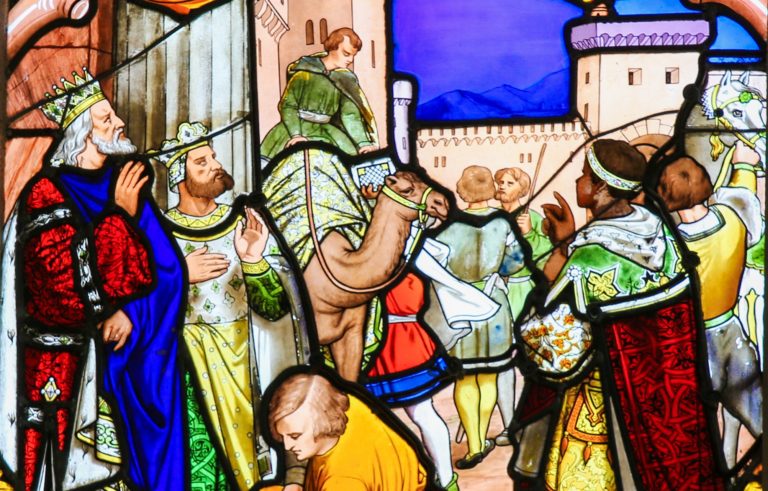This is the first installment in a series tilted “Eyewitnesses of the Nativity.” The text is an excerpt from Pastor Josh Moore’s sermon preached from Luke 1:26 to 2:7 at Red Door Church on 12/3/2023.
The Creche
As we begin our seasonal traditions, one of things we often do is to set out a nativity scene or what some call a creche.
It is common to hear that Francis of Assisi created the first nativity in the early 13th century after making a trip to the Holy Land and the place of Christ’s birth. It is said that he returned from that trip and assembled a living nativity scene including an ox, donkey and child. After this, it is said, this became a trend of sorts for churches to put out living nativities, which eventually gave way to statues and other representations of the events on that holy night.
Though Francis of Assisi’s is the first living nativity, at least that we know of, art scholars say that there are actually much earlier attempts to display the nativity, that go back even to the 3rd century. One of the earliest attempts to depict the Virgin Mary, mother of Jesus, can be found in the Catacomb of Priscilla under the streets of Rome. It depicts her nursing the Infant Jesus. There is another figure in the painting that some believe to be the prophet Balaam pointing to a star. The star is mentioned in Numbers 24:17.
“A star will come out of Jacob; A scepter will rise out of Israel.”
Numbers 24:17
As we look back across the centuries it is fascinating to see how the nativity scene has evolved.
In some nativities, Mary is seated, depicting her having had a painless childbirth. In others she is lying down on a bed, capturing physical exhaustion after labor. Some nativities have Jesus and Mary inside a cave instead of a barn or manger. In these the angels are hovering over the cave and Joseph is often depicted outside. Some depictions of the nativity even included prophets like Isaiah and Ezekiel. Later on nativities began to depict Mary kneeling by the Christ child in worship instead of in the immediate aftermath of childbirth. Joseph too is often seen kneeling.
Each of these variations is attempting to show something about this holy night when God visited earth.
What Nativities are Trying to Show Us
Of course, it goes without saying that nativities do not actually show us the details of the story in a historically accurate way. The bible doesn’t mention animals nearby when Jesus was born. It also says the angels appeared to the shepherds in the fields. We do not know if the angels approached the place of birth. Moreover, the Magi did not arrive in Bethlehem immediately following the birth of Jesus but later on when Jesus and the family were in a home.
So there are a number of elements that are not entirely accurate, but let’s not miss their larger point—what are they trying to show us?
I believe that what they are showing us, in one way or another, is a depiction of some of the eyewitnesses of the nativity—those who had the blessing and honor of bearing witness to the coming of the Christ child in one way or another.
In this brief six-week series I want to take a few weeks and think a little about each of these eye-witnesses and little of what they reveal to us about the Christ-child.
In this first installment we are going to look at this story from the perspective of the angel.
This angel will represent the angel that we have from our passage this morning (Luke 1:26 to 2:7) in the text, though admittedly in some nativities, the angels probably represent those that appeared to the shepherds in their fields.
What can we learn from the perspective of the angel?
Of course like everything in the Scriptures, there is much to learn here but maybe there’s just one or two things we can take away.
The Angel in Luke 1
Angels throughout the bible are seen as messengers. Angels were created by God but are subordinate to him and serve him.
Angels are spirit beings with many qualities like ours. They have personalities and a will just like we do. However, they do not become human beings, nor do human beings become angels. They are a different order of being.
When you look at the Scriptures what do we see the angels doing?
We see angels praising God (Psalm 148:1-2; Isaiah 6:3). We see them worshiping God (Hebrews 1:6; Revelation 5:8-13). They delight in what God does (Job 38:6-7). They serve God (Psalm 103:20; Revelation 22:9). They appear before God (Job 1:6; 2:1). They are instruments of God’s judgments (Revelation 7:1; 8:2). They bring answers to prayer (Acts 12:5-10). They play a role in winning people to Christ (Acts 8:26; 10:3). They encourage in times of danger (Acts 27:23-24). They care for the righteous at the time of death (Luke 16:22). We know that some angels are presented as warriors who fight spiritual battles. Jesus in the garden of Eden says that He had more than twelve legions of angels at his disposal if he simply called upon them for help. (See See www.gotquestions.org/angels-long-to-look-into-these-things.html for more information.)
One thing we see from all the good angels in Scripture, is that they delight to obey and serve God. There are fallen angels that we now know as demons but to discuss that would take us beyond the scope of our lesson today.
Verse 26 tells us that this angel is the angel Gabriel. What do we know about the angel Gabriel?
The Bible says that Gabriel was a messenger of God that was entrusted to give several important messages. The first one that is mentioned in the bible is to the prophet Daniel. He came to explain a vision to Daniel. He is described in that passage as flying, as are angels in other places, which is probably why angels are often depicted with wings even though the bible never says that angels have wings.
Gabriel was also given a message to deliver to Zechariah, John the Baptist’s father, to tell him that his wife who had been barren all of her life, was to conceive a child in her old age. Finally, Gabriel brings a message to Mary in our passage today.
Gabriel is the only angel that is mentioned by name in the Gospels. Michael is the only other angel named in all of the Bible. In some Jewish writings outside the Bible, Gabriel appears in many lists of leading angels. In the Bible, however, the focus is not upon the angels but upon Jesus himself.
And that is what we see here in our account today: the focus is upon Jesus.
What does the angel see here in our story? What is his unique eyewitness perspective?
Look with me at verse 28:
“The angel went to her and said, “Greetings, you who are highly favored! The Lord is with you.”
Luke 1:28
Every time Gabriel appears to a person, Daniel, Zechariah, and Mary, there is fear. This angel was no doubt an intimidating creature that would have been frightening to see. Yet, what we find here is no big fuss made about the angel. Instead, twice in this little exchange tells Mary that she has found favor with God.
Here is Gabriel, a special angel that has delivered many special messages to God’s people, who dwells in the presence of Almighty God and yet he makes no fuss about any of that. Rather he wants to impress upon Mary that she has found favor with God.
Things Which Angels Long to Look Into
You see the miracle here is not the angel. The amazing thing about this exchange is not the appearance of the angel. The miracle is that God is making a way to be with sinners. This is what the angel marvels at here.
Scripture says that these are things that even the angels long to look into. If you were to flip over to 1 Peter 1 and read verses 10 through 12 you would read that our salvation is something that even the angels long to look into these things. What does that mean?
One writer writes these words about that passage in 1 Peter:
‘Believers in Jesus Christ understand what it is like to be dead in sin and alienated from God (Ephesians 2:1–3). They also understand the overwhelming grace and mercy shown in Christ dying the death they deserve (Ephesians 2:13). They are adopted into the family of God, and their relationship with God is redeemed (Romans 8:14–17). Angels, on the other hand, do not know the sweetness of redemption. They have no experiential knowledge of grace and salvation. Angels in heaven have not been separated from God, nor have they personally known reconciliation or the depth of intimacy that follows. It is a foreign concept that piques their curiosity. The Greek word for “to look into” means “to physically stoop down, peer intently, and inspect curiously.” Over the course of human history, angels have had a front row seat in watching God’s redemptive work with humanity (1 Timothy 3:16). The book of Hebrews describes them as “ministering spirits sent out to serve for the sake of those who are to inherit salvation” (Hebrews 1:14, ESV). They are amazed by salvation and lean in attentively, longing to understand its mysteries.’
See www.gotquestions.org/angels-long-to-look-into-these-things.html
Even though the angel Gabriel lives in the presence of God, there are things about God that he will never understand. Things which you and I get to experience, things which Mary here got to experience.
Be amazed, God has made a way for sinners to step into the presence of God. But first, and equally amazing, God stepped down into our world and became a man. This is the Good News we remember during the season of Advent.
Let us all marvel with the angels.



